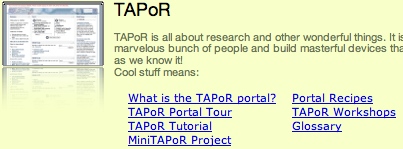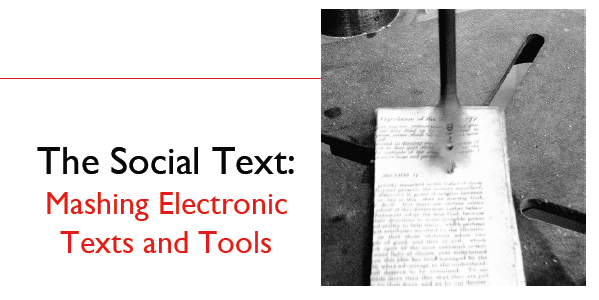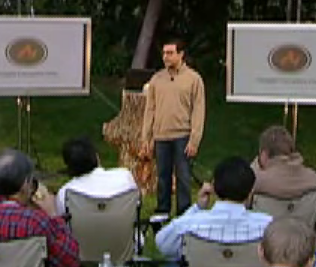
WikiTADA, the wiki of the loose Text Analysis Developers Alliance has a new interface that highlights the projects that are documenting themselves in an “open research” fashion.

WikiTADA, the wiki of the loose Text Analysis Developers Alliance has a new interface that highlights the projects that are documenting themselves in an “open research” fashion.
Right after Christmas I was involved in two events at the MLA. I organized and presided over a session on Open Digital Communities which was nicely written up by the Chronicle of Higher Education, Tech and the Humanities: A Report from the Front Lines – Chronicle.com.
I also participated in a newish format for the MLA – what is now being called a digital roundtable on Textual Visualization organized by Maureen Jameson where I showed visualization tools available through TAPoRware and the TAPoR portal.
I came across a very nice visualization by Fairyring (Stephanie Hendrick, a student at the HumLab) after finding that she had been experimenting with TAPoR visualizations and posting them to her Flickr account. In her comments she said she had used the visualization system, GUESS: The Graph Exploration System.

At the beginning of November I was asked to give a keynote for a Digital Scholarship/Digital Libraries symposium at the beautiful of Emory Conference Centre. My talk was titled “The Social Text: Mashing Electronic Texts and Tools” and my thesis was that we needed to forge a closer relationship between scholarly projects and digital libraries. This is a two-fold call for change:
A copy of the slides in PDF is up for FTP access. The file is 15 MB.
 Two days ago, on the day of All Hallows (All Saints), Google announced OpenSocial a collection of APIs for embedded social applications. Actually much of the online documentation like the first OpenSocial API Blog entry didn’t go up until early in the morning on November 2nd after the Campfire talk. On November 1st they had their rather hokey Campfire One in one of the open spaces in the Googleplex. A sort of Halloween for older boys.
Two days ago, on the day of All Hallows (All Saints), Google announced OpenSocial a collection of APIs for embedded social applications. Actually much of the online documentation like the first OpenSocial API Blog entry didn’t go up until early in the morning on November 2nd after the Campfire talk. On November 1st they had their rather hokey Campfire One in one of the open spaces in the Googleplex. A sort of Halloween for older boys.

Screen from YouTube video. Note the campfire monitors.
OpenSocial, is however important to tool development in the humanities. It provides an open model for the type of energetic development we saw in the summer after the Facebook Platform was launched. If it proves rich enough, it will provide a way digital libraries and online e-text sites can open their interface to research tools developed in the community. It could allow us tool developers to create tools that can easily be added by researchers to their sites – tools that are social and can draw on remote sources of data to mashup with the local text. This could enable an open mashup of information that is at the heart of research. It also gives libraries a way to let in tools like the TAPoR Tool bar. For that matter we might see creative tools coming from out students as they fiddle with the technology in ways we can’t imagine.
The key difference between OpenSocial and the Facebook Platform is that the latter is limited to social applications for Facebook, as brilliant as it is. OpenSocial can be used by any host container or social app builder. Some of the other host sites that have committed to using is are Ning and Slide. Speaking of Ning, Marc Andreessen has the best explanations of the significance of both the Facebook Platform phenomenon and OpenSocial potential in his blog, blog.pmarca.com (gander the other stuff on Ning and OpenSocial too).
 With colleagues Stéfan Sinclair, Alexandre Sevigny and Susan Brown, I recently got a SSHRC Research and Development Initiative grant for a project Mashing Texts. This project will look at “mashing” open tools to test ideas for text research environments. Here is Powerpoint File that shows the first prototype for a social text environment based on Flickr.
With colleagues Stéfan Sinclair, Alexandre Sevigny and Susan Brown, I recently got a SSHRC Research and Development Initiative grant for a project Mashing Texts. This project will look at “mashing” open tools to test ideas for text research environments. Here is Powerpoint File that shows the first prototype for a social text environment based on Flickr.
From the application:
The increasing availability of scholarly electronic texts on the internet makes it possible for researchers to create “mashups” or combinations of streams of texts from different sources for purposes of scholarly editing, sociolinguistic study, and literary, historical, or conceptual analysis. Mashing, in net culture, is reusing or recombining content from the web for purposes of critique or creating a new work. Web 2.0 phenomena like Flickr and FaceBook provide public interfaces that encourage this recombination (see “Mashup” article and Programmableweb.com.) Why not recombine the wealth of electronic texts on the web for research? Although such popular social networking applications as mashups seem distant from the needs of humanities scholars, in many ways so-called mashups or repurposing of digital content simply extend the crucial principle developed in humanities computing for the development of rich text markup languages: that content and presentation should be separable, so that the content can be put to various and often unanticipated uses.
Mashing Texts will prototype a recombinant research environment for document management, large-scale linguistic research, and cultural analysis. Mashing Texts proposes to adapt the document repository model developed for the Text Analysis Portal for Research (TAPoR) project so that a research team interested in recombinant documents can experiment with research methods suited to creating, managing and studying large collections of textual evidence for humanities research. The TAPoR project built text analysis infrastructure suited to analysis of individual texts. Mashing Texts will prototype the other side of the equation ��� the rapid creation of large-scale collections of evidence. It will do this by connecting available off-the-shelf open-source tools to the TAPoR repository so that the team can experiment with research using large-scale text methods.
We’ve been playing with ways to make text analysis tools like word clouds that don’t need parameters work automatically on loading a page. See TAPoRware Word Cloud documentation. Here is an example.
 BC.NET has a story on Shakespeare Across the Ether: Transmitting Digital Literature to Researchers Anytime, Anywhere which is about the TAPoR project at the University of Victoria. It talks about my friend Ray Siemens and digital humanities work on the Renaissance English Knowledgebase.
BC.NET has a story on Shakespeare Across the Ether: Transmitting Digital Literature to Researchers Anytime, Anywhere which is about the TAPoR project at the University of Victoria. It talks about my friend Ray Siemens and digital humanities work on the Renaissance English Knowledgebase.

With Swivel you can explore other people’s data, graph different data sets, comment on graphs, and blog your results. It is a clean idea to get people experimenting with data. I wonder how we could provide something like this for texts?
Thanks to Sean for this.
Last Thursday I gave a paper on “The Text of Tools” at the Society for Textual Scholarship annual conference in New York. I was part of a session on Digital Textuality with Steven E. Jones and Matthew Kirschenbaum. Steven gave a fascinating paper on “The Meaning of Video Games: A Textual Studies Approach” which looked at games as texts whose history of production and criticism can be studied, just as textual scholars study manuscripts and editions. He is proposing an alternative to the ludology vs. narrativity approaches to games – one that looks at their material production and reception.
Matt Kirschenbaum presented a paper titled “Shall These Bits Live?” (See the trip report with the same title.) that looked at preservation and access to games. He talked about his experience studying the Michael Joyce archives at the Harry Ransom Humanities Research Centre. He made the argument that what we should be preserving are the conditions of playing games, not necessarily the game code (the ROMs), or the machines. He pointed to projects like MANS (Media Art Notation System) – an attempt to document a game the way a score documents the conditions for recreating a performance. This reminds me of HyTime, the now defunct attempt to develop an SGML standard for hypermedia.
In my paper, “The Text of Tools” I presented a tour through the textuality of TAPoR that tried to show the ways texts are tools and tools are texts so that interpretation is always an analysis of what went before that produces a new text/tool.
Update. Matt has sent me a clarification regarding preserving the game code or machines,
I’d actually make a sharp distinction between preserving the code and the machines. The former is always necessary (though never sufficient); the latter is always desirable (at least in my view, though others at the Berkeley meeting would differ), but not always feasible and is expendable more often than we might think. I realize I may not have been as clear as I needed to be in my remarks, but the essential point was that the built materiality of a Turing computer is precisely that it is a machine engineered to render its own
artifactual dimension irrelevant. We do no favors to materiality of computation by ignoring this (which is what one of the questioners seemed to want).